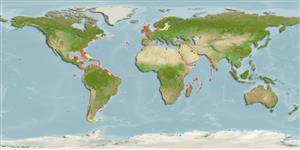Ulvophyceae |
Ulvales |
Ulvaceae
Environment: milieu / climate zone / depth range / distribution range
Ecology
Epiphytic; brackish. Tropical
Atlantic and Indo-Pacific.
Length at first maturity / Size / Weight / Age
Maturity: Lm ? range ? - ? cm Max length : 20.0 cm H male/unsexed; (Ref. 801)
Fronds are up to 20 cm in height. This is used as bait in fish traps (Ref. 801). Occurs in shallow intertidal mangrove prop roots and wood, or epiphytic in brackish water of estuaries (Ref. 83908). Also on subtidal volcanic rocks (Ref. 80999).
Life cycle and mating behavior
Maturity | Reproduction | Spawning | Eggs | Fecundity | Larvae
Guiry, M.D. and G.M. Guiry. 2009. (Ref. 80701)
IUCN Red List Status (Ref. 130435)
CITES status (Ref. 108899)
Not Evaluated
Not Evaluated
Threat to humans
Human uses
Bait: occasionally
| FishSource |
Tools
More information
Age/Size
Growth
Length-weight
Length-length
Morphology
Larvae
Abundance
Internet sources
Estimates based on models
Preferred temperature
(Ref.
115969): 8.8 - 23.9, mean 11.9 (based on 987 cells).
